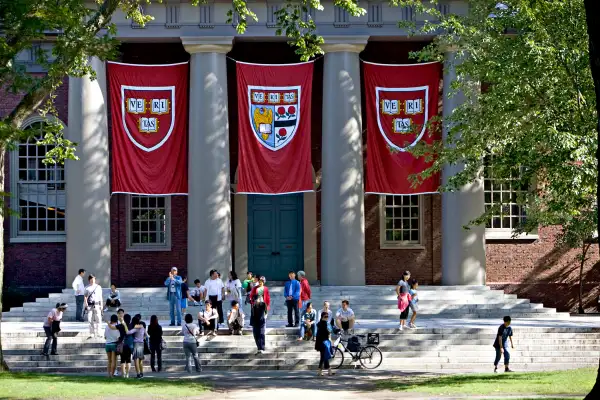3 Reasons That Harvard's Endowment Is Losing to Yale's
Money is not a client of any investment adviser featured on this page. The information provided on this page is for educational purposes only and is not intended as investment advice. Money does not offer advisory services.

The largest educational endowment in the world is under new management, and it's easy to see why.
Harvard Management Co., which oversees Harvard's mammoth $36 billion endowment, has named Columbia University's investment chief N.P. Narvekar as its new CEO. At Columbia, Narvekar produced annual total returns of 10.1% over the past decade, which trounced the 7.6% annual gains for Harvard.
The hiring comes days after Harvard's investment fund reported a loss of 2% in the 12 months ended June 30. Making matters worse, rival Yale announced that its $25 billion endowment grew 3.4% during that same stretch, leading the student editors of the Harvard Crimson to declare: "This is unacceptable."
The prior year wasn't much better. While Harvard's endowment gained 5.8% in the prior fiscal year ending June 30, 2015, that performance ranked second-to-last among all Ivy League endowments, earning half the returns of Yale.
Normally, differences of this magnitude can be chalked up to basic strategy. But the fact is, Harvard and Yale invest rather similarly. Instead of simply owning stocks and bonds, both endowments spread their wealth among a broader collection of assets that include U.S. and foreign stocks, U.S. and foreign bonds, real estate, natural resources, "absolute return" funds (which are hedge-fund-like strategies), and private equity.
Still, there are subtle differences between the two approaches. And while most investors don't have access to—or interest in—exotic alternatives like private equity and venture capital funds, the differences between the performance of the Harvard and Yale endowments offer a few lessons for all investors.
#1) Focus your attention on what really matters.
Academic research shows that deciding on which assets to invest in—and how much money to put in each type of investment—plays a far bigger role in determining your overall performance than the individual securities you select.
But while Harvard and Yale's investment management teams both spend time concentrating on their "asset allocation" strategies, only one gives it its full attention.
Yale runs a fairly streamlined office with a staff of just 30. That's because the actual function of picking and choosing which stocks or bonds or real estate holdings to invest in—and how best to execute the actual trades—is farmed out to external managers at professional investment firms.
This allows the Yale Investments Office to spend all its time figuring out the optimal mix of investments based on their needs and the market climate.
Harvard, on the other hand, runs what's called a "hybrid" system. In addition to setting asset allocation policies and hiring external managers like Yale does, the investment staff at Harvard Management Co. also directly invests a sizeable portion of the endowment itself, selecting securities and being responsible for executing the trades.
This is why HMC employs more than 200 staffers by comparison.
Yet as Harvard's recent performance shows, it's hard to be good at all aspects of investing.
Indeed, Robert Ettl—who has been serving as HMC's interim chief executive and will become chief operating officer under Narvekar—noted in a recent report that the endowment's disappointing showing "was driven primarily by losses in our public equity and natural resources portfolios."
Ettl went on to note that "we have repositioned our public equity strategy to rely more heavily on external managers"—a tacit admission that Harvard's internal equity managers were probably responsible for a decent portion of that poor performance.
And as for the natural resources segment of HMC's portfolio—which involves owning physical commodities such as timber on plantations owned and managed by Harvard—that lagged its benchmark performance by a massive 11 percentage points in fiscal year 2016. As a result, Ettl said HMC recently replaced the internal head of its natural resources portfolio.
#2) Turnover is never good, especially when it comes to management.
At Yale, David Swensen has managed the school's endowment for 30 straight years, generating annual returns of about 14% throughout his tenure, far in excess of his peers and the broad market. That long, stable tenure has allowed Yale to maintain such a consistent strategy—of being willing to delve into somewhat risky and illiquid assets including venture capital, private equity, hedge funds, and physical assets—that this approach is now called "the Yale Model."
Harvard is another story altogether.
When Narvekar assumes his duties at HMC on December 5, he will be the eighth manager to lead Harvard's investment portfolio—including interim heads—in the past 12 years.
And each manager has put his or her own spin on the underlying investment style, forcing the endowment to switch gears every few years.
For example, Mohamed El-Erian, who briefly ran the endowment before leaving to become CEO and co-chief investment officer at PIMCO, increased the endowment's use of derivatives and hedge funds and exposure to the emerging markets. El-Erian's successor Jane Mendillo then took the fund in a more traditional direction. But she had the unenviable job of unwinding HMC's exposure to El-Erian's illiquid bets during the global financial crisis.
Every time the endowment deploys new strategies and unwinds old ones, turnover rises. And high portfolio turnover usually leads to poor performance, higher costs, and more taxes.
#3) Don't try to copy other investors. Success is hard to replicate.
Under both Stephen Blythe, who served for less than a year and a half before taking medical leave, and interim CEO Ettl, Harvard Management has shifted a greater portion of its equity strategy to external managers—in apparent emulation of Yale.
Narvekar himself is said to be closer to Yale's Swensen, operating a relatively small staff that relies exclusively on external managers.
But it's hard enough for successful managers to replicate their own success. It's doubly hard trying to emulate other successful investors.
In fact, David Swensen at Yale is on record as saying that individual investors should not even try to copy what Yale is doing with its endowment.
Instead, Swensen tells investors to keep things simple by establishing a broadly diversified portfolio and then using low-cost, low-turnover index funds as vehicles of choice.
Ironically, some investment managers argue that this is a strategy that Harvard's endowment should focus on as well.
While Harvard's endowment has beaten the broad stock and bond markets over the past 15 years, on a risk-adjusted basis, it has actually done no better than a basic 60% stock/40% bond approach.
This may explain why financial adviser Barry Ritholtz has argued that rather than trying to emulate the Yale Model, Harvard should be taking a page from Calpers, the giant pension fund manager that invests on behalf of California's public employees.
A couple of years ago, Calpers made a big splash by saying that it would be cutting back on its use of expensive actively managed strategies, including hedge funds, while focusing more on low-cost index funds, which simply buy and hold all the securities in a given market.
Now those are lessons—low costs, index funds, and buy and hold—that apply to your 401(k) as much as they do to Harvard's endowment.
